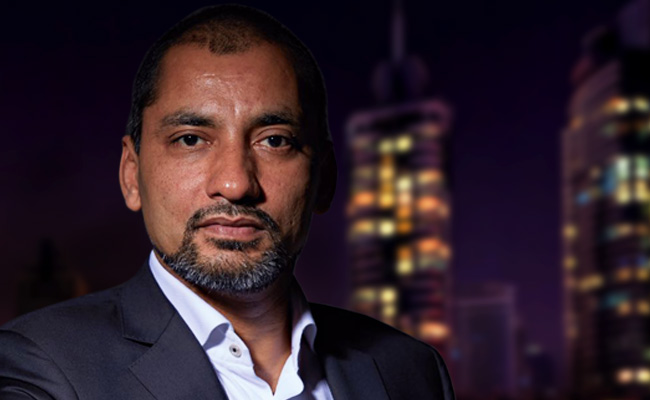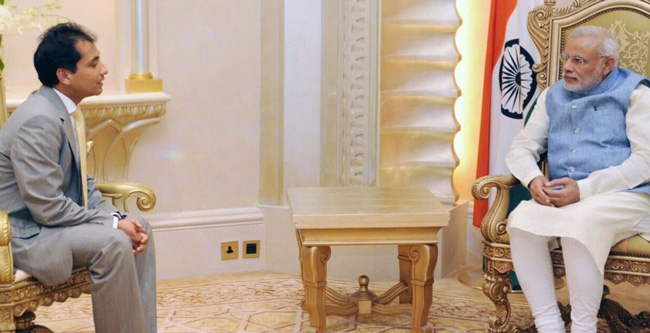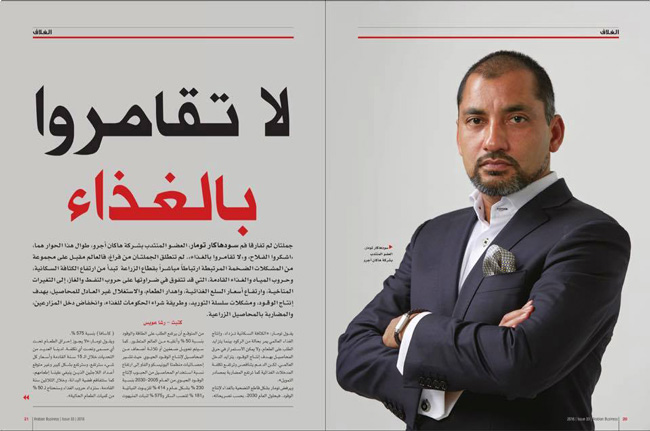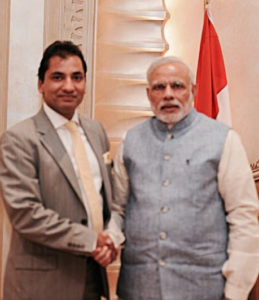Even when in his office in Dubai, Hakan Agro’s managing director keeps his native rural India close to his heart.

By Dario Bard
This article originally appeared on www.goift.com
On August 16, 2015, while on a state visit to the United Arab Emirates, India’s Prime Minister Narendra Modi met with Sudhakar Tomar, the managing director of Dubai-based Hakan Agro DMCC, one of the largest agricultural and food commodities origination and supply chain companies in the Arabian Peninsula.
At that meeting, both men discussed the food security and malnutrition challenges facing India, the world’s leading pulse producer, consumer and importer. Following their conversation, Tomar was asked to present a white paper outlining his vision for tackling these issues.
Eight months later, Hakan Agro’s managing director was involved in high level talks with several members of the Prime Minister’s cabinet. Those talks helped contribute to concrete actions, including an increase in India’s agriculture and farmer welfare allocation to US$ 5.5 billion, a renewed focus on pulses, a US$ 9 billion allocation for the recharging of groundwater in areas hit by drought, the bringing of 28.5 million hectares under irrigation and an additional half a million under organic farming, the setting aside of a US$ 3 billion irrigation fund, and the establishment of a crop protection scheme featuring nominal premiums and the highest compensation for crop loss that India’s growers have ever seen.
Not bad for the son of a smallholder farmer from the town of Hardoi in India’s State of Uttar Pradesh. Indeed, Sudhakar Tomar has come a long way. Of his early years, Tomar says he was fortunate enough to have had a “happy and colorful childhood,” but he also remembers being acutely aware of the poverty that accompanied the life of subsistence farming. Schooling was poor, sanitation was lacking, and disease and malnutrition were prevalent.

“I can clearly recall the ever present daily struggle for my family’s material survival,” he says. “There came a time when the family’s silver and land had to be pledged to loan sharks at the draconian annual interest rate of 200%. It took a long time and a great deal of courage on my father’s part to reclaim the pledged land and redeem the family’s dignity.”
To provide for his family, Tomar’s father, like many others in his situation, joined the state police force, leaving his wife to tend to the farm. As part of his law enforcement duties, he travelled from village to village, often taking his four-year old son, Sudhakar, with him.
“I suppose those nomadic early years developed in me a sense of empathy, a will to survive and an ability to connect with people from all walks of life,” reflects Tomar.
The memory of those formative experiences led him to devise two mottos to live by: “Be grateful to farmers” and “Don’t gamble with food”. He has advocated for these principles over the course of his professional career, during which he has amassed countless honors. In 2016 alone, he was named one of the Top Indian Leaders in the Arab World by Forbes Middle East and was honored with the Business Leader of the Year Award by the DMCC, the Dubai authority on trade, enterprise and commodities.
IFT had the opportunity to ask Tomar about his efforts on behalf of subsistence farmers and his conviction that pulses hold the key to addressing global malnutrition and feeding the world.
IFT: How did you get your start in the pulse trade?
Tomar: It is interesting because at university I earned a Bachelor in Plant Sciences, Zoology and Geology from Canning College at Lucknow University in Uttar Pradesh, which is the most populous state in India. I loved geology and botany, but for several reasons I did not pursue post-graduate or doctoral studies in those areas. Instead I enrolled in an MBA program, in part because the job prospects were better. During my MBA, I did a rigorous summer internship at the Aditya Birla Group, then a US$ 35 billion company, to trade agricultural commodities, pulses and fertilizers. That was in the early ’90s. Following that internship, at the age of 21, the Aditya Birla Group offered me my first job.
It seems I did reasonably well there, and in 1995 I was sent to Dubai to open an office in the Jebel Ali Free Zone, and that same year I started up operations in Syria and Turkey. Then in 1997 I teamed up with my partners in Hakan Agro Group as the managing director. Hakan Agro DMCC is a true homegrown multinational company, headquartered in Dubai with offices, factories, distribution hubs and farming operations in 30 countries. We export nearly 3 million MT of agricultural commodities per year, with annual sales totaling about US$ 1.5 billion.
IFT: Yours has been an illustrious career that has brought you much recognition, including being named one of the Top Indian Leaders in the Arab World by Forbes Middle East this year. What does this honor mean to you personally?
Tomar: As a soldier for and supporter of all causes related to improving food security, this and other awards have provided me with a platform to voice my opinion. For this I owe a mountain of gratitude to all our well-wishers, especially those in the Global Pulse Confederation, the Dubai Multi Commodities Centre and the governments of India and the UAE.

IFT: All that recognition also brought you to the attention of Prime Minister Modi of India. What can you tell us about your meeting with him?
Tomar: It was a fascinating and overwhelming experience to say the least. It gave me the opportunity to brief him about Hakan Agro’s global operations and our corporate social responsibility initiatives to improve food security, farmer outreach and inclusion, and promote pulses as a means of addressing the problem of malnutrition in India.
India is blessed with 270 days of sunshine a year, annual rainfall of 900 mm, diverse agro-climate conditions that allow for three harvests per year, extraordinary biodiversity, more than 7,000 km of coastline, hundreds of rivers crisscrossing the country, and more than 1.3 billion progress-loving people. In other words, India has all the resources it needs not only to become totally self-sufficient in terms of its food supply, but also to generate a surplus in agricultural commodities and value added products for export markets.
In India, we have four major demand drivers: the widening demand-supply gap in some major crops like pulses and oilseeds; rising incomes; population growth; and rising aspirations. Additionally, we have four major factors limiting production: land constraint; water shortage; malnutrition; and the constant threat of climate change.
The farm sector is critical to India’s GDP growth. It provides subsistence for more than 70% of the workforce, although its contribution to the GDP is only 17%. Unproductive agriculture is an unsustainable burden on the national economy and this has to change.

IFT: How has the government responded to your ideas?
Tomar: When the government released its annual union budget for 2016, I was overwhelmed to see that it reflected many of my recommendations.
The budget includes several revolutionary changes that will alleviate the negative effects of years of dysfunctional policies that kept farmers poor and uneducated, making them incapable of pursuing their own best interests in the long term.
IFT: One of those changes is the creation of a 2 million MT buffer stock of pulse crops. What effect might this have on the global pulse trade?
Tomar: If properly administered, it should cool down spikes and extreme volatility in the market. However, the government needs to make sure all pulses are covered in the local and international procurement framework, including yellow peas, which are the cheapest and most efficient pulse in terms of protein. Slow and steady pulse purchases on the part of India will ensure that prices remain competitive and world markets are not disturbed.
IFT: You have spoken extensively about the issues of food security and malnutrition. What is the origin of your interest in these issues and in your pro-farmer stance?
Tomar: I would say I was born into it. Coming from a farming family has kept me rooted, grounded and compassionate when it comes to poor farmers across the globe. Growing up, I was blessed with a ringside yet humane view of the plight of subsistence farming and the problems of poverty. From an early age, I breathed and felt what it was like to be a poor farmer back home in rural India. I also ran a rice mill in Haryana, so I understand the perspective of the factory operator, too. And of the exporter, importer, multinational global trader, large scale industrial farmer, policy maker and, last but not least, the consumer.
Food is a socio-political-economic commodity throughout the world. We need to make sure no one goes hungry while also paying farmers what they deserve. Farmers in India, Asia and Africa do not get the rewards and wages they deserve. In Asia and Africa, agriculture is a very high risk business; it relies on rain and when conditions are dry, you have a disaster. India and the 53 nations of Africa account for more than half of the world’s population and have abundant resources and resilient people to sustain the future of food. In the next thirty years, we need to double food production to feed the world. The farmers in India and Africa are the strongest but also the most under-appreciated link in the global food system value chain.
IFT: How so?
Tomar: Take the case of India. India’s rural areas are home to nearly 70% of the country’s population, most of which relies directly or indirectly on agriculture to survive. The region in which most subsistence farmers live is semi-arid and has little access to water. Only 48% of India’s land is arable, and of that an even smaller percent yields an adequate crop. Farmers also face the daunting task of transporting their produce to market; that is, if a market is even available. Because of the lack of irrigation systems and funding, the crop produced by the family farm is often not marketable; no surplus is produced for sale.
For these reasons, these farmers are often under-appreciated and overlooked, but they are the key to food security for their countries.
Consider that in India we import 5 million to 6 million MT of vegetable protein and another 15 million MT of edible oils. This year, we may also import 3 million MT of wheat. Considering we are a nation of 1.2 billion people, importing 25 million MT of food crops is not that huge a number. To a large extent, we are self-sufficient in wheat, rice and sugar, but the great challenge is feeding people nutritional food.
Hitherto, India’s food security program depended mostly on the procurement and distribution of wheat, sugarcane and rice. As a result, the country is largely self-sufficient in those foods, but at the cost of others, such as pulses and oilseeds.
To this day, nearly a billion people depend primarily on rice and wheat for their main meal, meaning they do not get the nutrients they need, and thus a large percentage of my fellow countrymen suffer from malnutrition.
At Hakan Agro, we are strong supporters of the current government’s initiatives to address this issue. The Modi administration has developed 20 smart programs ranging from irrigation to crop insurance, providing seeds and technology in order to increase farm income fivefold. Personally, my dream is to see farmer income increased tenfold, so that seven out of ten people become material contributors to India’s economy.
But for this to happen, we must treat the farmer with respect. He is the strongest link. He may not be biggest, but he is certainly the strongest.
IFT: You proposed a six-point sustainable solution to feed Africa and Southeast Asia. Could you talk about it?
Tomar: Sure. The first point is improving crop yields for farmers there. This includes reducing waste at the farm and in the supply chain. Globally, we lose more than 13% of food crops in the field, storage, during distribution and at the individual level. We can reduce this loss in several ways, such as integrated pest management and more in situ processing and warehousing.
Second, we need to promote healthy food choices. Consumers should be encouraged to rely more on vegetable protein and super foods like pulses. The International Year of Pulses is tremendously important in this regard.
Third, we need to reduce food waste on the consumer end. This could save another 30% on food that goes from the table to the garbage bin. Just imagine the amount of food that gets thrown out because it expires in the fridge or is leftover in buffets. We need a change in eating habits, such as encouraging smaller portions.
Fourth, we need to embrace technology and make it work to shrink the supply chain. I am a strong supporter of a direct relationship between farmers and consumers. The mismatch between what a farmer gets versus what a consumer pays at the retail level cannot continue forever. The day will come when everything will be purchased through a smartphone app and delivered directly to the consumer. This kind of “uberization” can rapidly shrink the price difference we are seeing from farm field to store shelf; this difference can be as much as 800%.
Fifth, we need to stop the speculation and price rigging in the food commodity exchanges of the developing world. The global food industry represents a US$ 5 trillion opportunity and we should promote it in an equitable manner to guarantee the prosperity of all participants. Exchanges work well in organized and robustly regulated markets with depth, where the main objectives are price discovery and risk management. But in poorly regulated markets, particularly in food deficit countries, food futures suffer from speculation. On principal, I am opposed to gambling with people’s food, homes and livelihoods in food deficient countries in the name of price discovery.
And last but not least, we need to empower the farmer to feed the world. This means paying them more. Agriculture is not a desirable and rewarding profession in India. We have to bring back the pride, financial reward and purpose of the agriculture profession.
To sum up, we have to use technology in every possible way. We have to reduce food waste, rebuild our nutrition systems using smart protein to reduce the cost of healthcare, thus creating the savings we need to improve farmland. If we do things the right way, we could increase productivity and pay the grower a reasonable amount, and make the right food available at the right place and at the right price.
IFT: What role do you see pulses playing?
Tomar: Pulses are the future of sustainable nutrition in India. They are affordable sources of protein and have a small carbon footprint. They are also water efficient crops that are suitable to India’s climate. In fact, pulses use only to one-tenth of the water needed to produce other sources of protein.
Further, lentils, peas, beans and chickpeas have been nourishing people around the world for thousands of years. In addition to addressing malnutrition, they can tackle many chronic health conditions, such as obesity and diabetes. They are delicious, highly versatile, have a long shelf life and are good for us and the planet.
IFT: In closing, can you give us your thoughts on India’s pulse crop outlook for 2016/17?
Tomar: Pulse production for the recently concluded Kharif season is projected to be up nearly 50% compared to last year on grower response to higher prices and better monsoon rains. The government pegs the pulse crop at 8.2 million MT, compared to 5.5 million MT last year.
For the upcoming Rabi season, the crop is forecast at 22.6 million MT. Production is expected to be up on strong grower interest in desi chickpeas due to high prices.
The government of India has taken several measures to control prices, including the 2 million MT pulse buffer stock we talked about. This combined with record harvests not only in India but also in all the key exporting origins means the global trade should see softer prices for 2016/17.